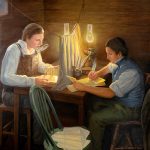Associated Locations:
- Prescot, Lancashire, England – Birthplace
Associated Dates:
- February 1, 1757 – Born
John Philip Kemble is one of the eminent spirits who appeared to President Wilford Woodruff in the St. George Temple on August 21, 1877. This interesting story is detailed in the Eminent Spirits Appear to Wilford Woodruff wiki.
“The late 1700’s saw a wondrous revival of Shakespeare. John Kemble and his sister Sarah, who became Sarah Siddons, and a great Shakespearean actress, were instrumental in this revival. These two, along with Dr. Samuel Johnson and actor David Garrick, did much to bring respect to the theater and to Shakespeare.” 1
“As far as diligence and assiduity are claims to merit, I trust I shall not be found deficient.”
– John Philip Kemble
Life Sketch from The Other Eminent Men of Wilford Woodruff
Copyright © Taken from the book: The Other Eminent Men of Wilford Woodruff. Special thanks to Vicki Jo Anderson. Please do not copy.
English Shakespearean Actor, Director 1757-1823

John Kemble returned Shakespeare to original scripts and sought for accuracy in costume and scenery. During most of the 1700’s theater was in a state of disrepute. Plays, even the remnants of Shakespeare, were mediocre. Theatrical costume were merely that of the contemporary fashion of the day. An actor playing a soldier of the crusade wore the uniform of a British general. Leading ladies in adaptations of Greek tragedies wore their hair powdered and dressed in richly trimmed dresses with large hoops. Historical application and research to period drama were largely unknown.
James Boaden, Kemble’s close friend and biographer, wrote:
[Kemble] saw that much was yet to be dome in the representations of his plays [that he produced], and determined, when he should acquire the necessary power, to bend every nerve to make them perfect, beyond all previous example. To do this, he was first himself to study the antiquities of his own and other countries; to be acquainted with their architecture, their dress, their weapons, their manners; and he by degrees. assembled about him the artists who would best carry his designs into effect.
To be critically exact was the great ambition of his life.” 2
Kemble studied all the branches of his art and read with infinite pains everything that related to his profession. He called it the archeology of drama.
Kemble turned what was then a questionable profession into an honored art of the highest scholarship. He brought to drama the respect that had been missing for more than a century, finishing the work David Garrick had begun. Though his attention to detail and his return to the original scripts of Shakespeare, theater began to enjoy one of its highest peaks of all time. It was on the vast ground of that poet that Kemble made his stand, says Boaden.
Early Life
John Philip Kemble was born on 1 February 1757, at Prescot in Lancashire. His father, Roger Kemble, was manager of a provincial company. His mother, Sarah Ward, was a daughter of the previous company manager. In 1746, Sarah’s father, gave a benefit play in the town hall of Stratford-upon-Avon, for the sole purpose of restoring the monument of Shakespeare in the church there.
3John’s parents and grandparents had an appreciation for Shakespeare even before the Shakespearean revival. It was into this multi-generational theatrical family that John Kemble and Sarah Kemble Siddons were born. Their unique background enabled these two children to do a great work for the fame of the world’s greatest dramatic poet.
Kemble’s parents had an impeccable reputation and high standards for which they were widely respected. Because theater was not a respectable occupation, they did not consider it as a choice for their children’s career. Because he was a Catholic, Mr. Kemble sent John to the Roman Catholic seminary in Staffordshire. Here John distinguished himself, did well in his studies, and was very diligent in all his courses. At the conclusion of his courses at the seminary, he was sent to Douay, a Catholic school in France maintained by British Catholics.
Kemble’s Education

At Douay Kemble received a classical education, of which he always spoke with admiration and gratitude. He became proficient in Greek and Latin and began to fell that the English translations of the Greek tragedies were not accurate enough. He read widely from the lives of the saints to the writings of the fathers of the church. This study of the classical and sacred literature caused him to consider studying for the ministry.
An incident during this time Illustrates both the depth of his intellect and of his commitment to people. His class, because of some indiscretions had been placed under severe restrictions. To redeem the class, a student was to recite two books of Homer by heart. Kemble quietly and modestly volunteered to accept the task on behalf of the class. Using his keen ability for detail and an uncommon memory, Kemble was able to memorize 1500 lines to free his class. This act endeared him to the whole class.4
Like the great historian Sir Edward Gibbon, Kemble felt from an early age that his life was destined for a mighty work, and for him it was to be the theater. Kemble returned from his studies to enter the stage, much to his father’s discomfort. He began his debut by traveling with a troupe of players. At one point, between billings, Kemble and and a fellow actor named Watson were reduced to searching out turnips in a field to keep from starving. While they were relishing in their modest feast they hit upon a novel idea to improve their finances. They planned for Kemble to act the part of a Methodist preacher and for Watson to act as clerk. As they neared the town of Twekesbury, they drew together in a field a numerous congregation. Kemble preached with such pathos and conviction and with so much effect, that the pair were soon rewarded with a large collection for their labors.
5Beginning to Write
In 1778, Kemble’s artistic talents began to flourish and establish his reputation. He had begun writing a play, a tragedy called ‘’Belisarius’’, which received some note. In 1780 he wrote a comedy, The Female Officer. On the first night of the performance he noticed the dragoon of Lord Percy, later known as the Duke of Northumberland, in the audience. He decided that several of his soldiers should have a part in the play. The head officer turned him down but, undaunted, he sought for an audience with Lord Percy. He gained that audience, and after explaining his need, Lord Percy granted the favor.
During the early 1780s, he delivered lectures in Edinburgh on the sacred and progane oratories. These were well received. Then in 1783, he joined his now famous sister, Sarah, on stage. Because her reputation drew large crowds, he was able to perform before many people, and his reputation grew.
David Garrick knew talent when he saw it. After viewing their performance, he convinced Kemble and his sister to leave the Covent Garden theater and perform in the famed Drury Lane theater. The brother and sister were widely acclaimed, particularly for their Shakespearean roles.
Becoming the Manger of Drury Lane Theater

In 1788, Kemble became manager of Drury Lane, which left him free to choose scripts, actors, and, to design scenery. One of his first productions were Henry VIII, which had not been produced for over fifty years. Kemble made major changes. Although star roles had been held only by those actors who had seniority, he opened up roles to new and budding artists. He prohibited the sitting on the stage by the audience, and began for the first time the selling of tickets in advance of the performance. Under his tutelage and his sister’s acting, Drury Lane flourished. But money problems arose when Sheridan, the owner, did not pay his actors according to contract. Kemble often had to pay his actors according to contract. Kemble often had to pay the angered actors out of his own pocket.
In 1796, a Shakespearean forgery appeared in the country, and Sheridan, the owner of Drury Lane, in order to make monetary gains, bought the rights to the play. Sarah withdrew from the cast. Kemble refused to bill the play as written by Shakespeare. One opening night, the audience, by the end of the second act, could see that the play was not of Shakespearean quality. They began to make noise. Kemble ended the evening as only a perfectionist of Shakespeare could end it, by quoting the line: “And when this solemn mockery is ended.”6 Finally, in 1802, the Kembles left Drury Lane, unable to work any longer under its present ownership.
Through a friend Kemble was able to negotiate with Covent Garden for one-sixth of the theater and the position as manager. In this new position he was able to let Shakespearean drama reign supreme. Kemble became the intellectual master of his art, and entry into the new century went well for him. His education and refined manners made him a sought after guest in the finest homes in London. Much of his popularity was due to the shrewd public relations of his devoted wife, Priscilla Hopkins, who performed her part well in the advancement of the theater. Even the Prince of Wales was fond of Kemble.
Burning of Convent Gardens

In 1808, tragedy struck. Covent Gardens caught fire and burned to the ground. Kemble’s hopes, dreams and finances all seemed to have disappeared. He was devastated; the loss was enormous! Twenty-two lives were lost. Scenery that had been so painstakingly researched and made, dresses, stage-jewelry, uniforms—all were totally burned. The theater had possessed Handel’s giant organ and a huge musical library, including irreplaceable scores of Handel. Kemble’s own extensive library of antiquity was lost.
Fortunately, Kemble had insurance on the building. It was not long before subscriptions began coming in to help rebuild the theater. Lord Percy himself gave £10,000.
7With this money and the insurance payment Covent Garden was rebuilt in grand style, Its seating capacity was enlarged to accommodate 2800 people. Such massive improvements left Kemble terribly in debt. To offset this debt he had to raise ticket prices. The public was angry. Playing to a full house on opening night, Sarah entered to perform and was shouted down with a loud chant: “Over-priced, over-priced.”
This went on for three months until Kemble gave up in and reduced the prices. In order to meet his debt, he began to produce extravagant plays to keep the theater full. It was a sorrowful turn for him from devotion to true theater.
In 1817, he played Coriolanus, giving his last performance before the most distinguished audience ever gathered in London. He retired to a country villa in Lausanne with his wife, where he spent much of his time gardening. Although he looked healthy, his health began to show the great strain it had been under for many years. During his last years, he studied his Bible every day and pondered greatly upon it. One visitor noted that the Bible study made him begin to look like Isaiah.
8Kemble died in February of 1823. He was sixty-six years old. He had helped bring the world of theater and the works of Shakespeare to heights never known before.
Copyright © Taken from the book: The Other Eminent Men of Wilford Woodruff. Special thanks to Vicki Jo Anderson. Please do not copy. 9
- Anderson, Vicki Jo. (1994). The Other Eminent Men of Wilford Woodruff. Cottonwood, AZ: Zichron Historical Research Institute.
- Manvell, Roger. Sarah Siddons: Portrait of An Actress. New York: G. P. Putnam’s Sons, 1971, p. 158.
- Boaden, James. Memoirs of the Life of John Philip Kemble, Esq. New York: Robert H. Small, Wilder & Campbell, 1825, p. 2
- Ibid., p. 6
- Duyckinck, Evert. Portrait Gallery of Eminent Men and Women. New York: H. J. Johnson, 1873, p. 242
- Manvell, p. 198
- French, Yvonne. Mrs. Siddons, Tragic Actress. London: Derek Verschoyle, n.d., p.224-25
- Baker, Herschel. John Philip Kemble. New York: Greenwood Press, 1942, p. 347
- Anderson, Vicki Jo. (1994). The Other Eminent Men of Wilford Woodruff. Cottonwood, AZ: Zichron Historical Research Institute.








One Response